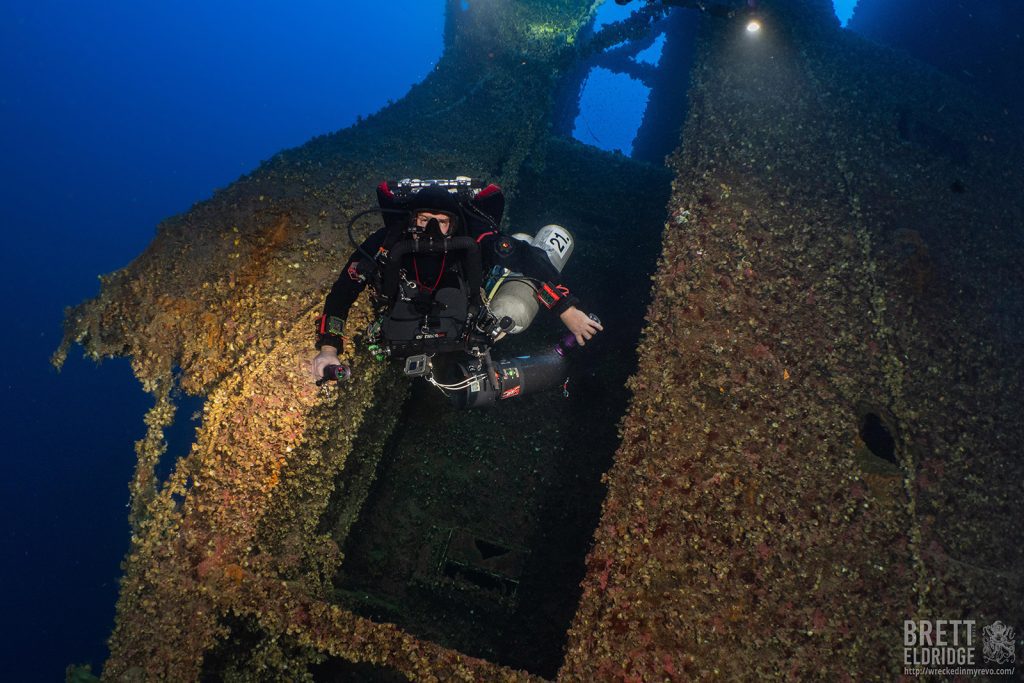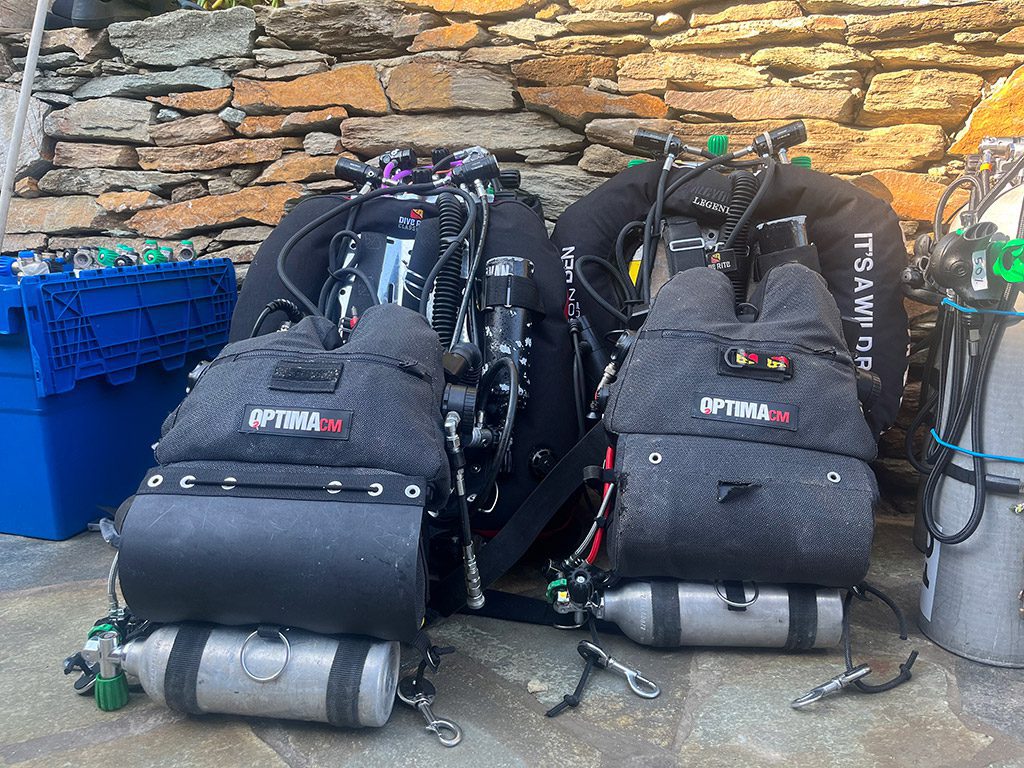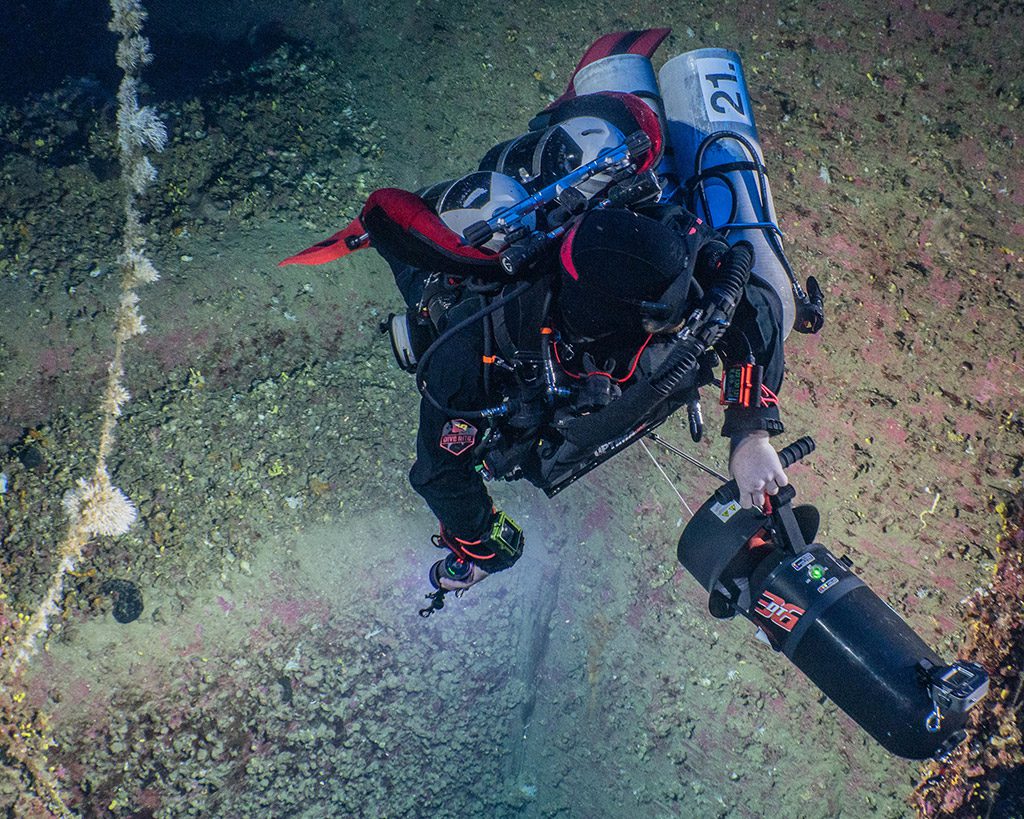Latest Features
Gas Planning With a Chest-Mounted Rebreather
Conducting a deep dive with a chest or sidemount rebreather using “Dilout” ( a combination of off-board diluent and bailout) has become more common with the advent of compact rebreather platforms. But there are issues to be considered. Here shipwreck enthusiast Justin Judd, details his and team mate’s gas planning approach for their recent CHO2optima dives on the HMS Britannic laying at a depth of 122m/400 feet.
by Justin Judd. Lede image: Justin Judd at the bridge of the Britannic. Photos by Brett Eldridge unless noted.

I started diving a backmount rebreather on the wrecks off of the coast of Southern California in 2017 after realizing open circuit helium was far too expensive. I was teaching full-time in 2019 and 2020, during which time I completed a significant number of 100 m/328 ft plus dives utilizing four to five bailout bottles per dive. At this point, one of my primary dive buddies, Ben Lair (Paragon Dive Group), started diving the recently released O2ptima CM rebreather. I was immediately sold when I realized he could do the dives that I was doing with a larger safety margin and fewer bailout bottles. I did my crossover with Ben and haven’t looked back.
The HMHS Britannic has been a bucket list trip for me for a long time. I jumped at the opportunity to dive it with Ben and Brett Eldridge (Wrecked in my rEvo) in the fall of 2023. Ben and I were both diving the O2ptima CM and Brett was diving a backmount rEvo, which meant he was managing a greater number of stage cylinders.

Making the Jump on the Britannic
For this trip, we knew we would be diving off of small RIBs (rigid inflatable boats) departing from Kea Island in Southern Greece, so we needed to take a minimalist approach to our equipment and bring everything we needed to safely complete a deep dive. During the trip’s planning phase, we determined that backmount doubles would be the most efficient way to carry our bottom gas. We decided to dive steel 12 L cylinders to accommodate for more gas. The fun part was determining which gases would make for the most efficient bailout plan while maintaining a good safety margin for PO2s.
The trip’s focus was the HMHS Britannic, which lies on its starboard side at the bottom of the Aegean Sea at around 122 m/400 ft deep. This wreck has over 30 m/100 ft of relief from the top of the wreck to the sand, so we knew that we would be spending only part of our dives at the maximum depth. We also had to take into account that our diluent was a part of our bailout gas, unlike the traditional approach when diving with onboard diluent.
Planning Your “Dilout”
There are significant logistics to consider when deep gas planning using a chest-mounted rebreather with “dilout,” a combination of offboard diluent and bailout which has become much more common with the recent advent of more compact rebreather platforms. The following logistics and gas planning apply to any deep diving utilizing a rebreather running dilout. The O2ptima CM proved to be an ideal tool for simplifying the logistics of these substantial dives. Ben and I believe we were the first divers to use chest-mounted rebreathers on this wreck.
Gas planning for a traditional backmount CCR tends to be simpler because divers have been using them in these depth ranges for decades, so there is a precedent for which gasses to use. Typically, this type of plan will utilize diluent with a PO2 of 1 to 1.1 bar and multiple bailouts with a PO2 of up to 1.4 to 1.6 bar in the ocean. This can result in a diver being required to carry four to five stages and a rebreather.
This doesn’t work particularly well for a CCR using dilout. In the event of a bailout, a dilout of 1 to 1.1 forces the PO2 to drop rapidly on ascent, adds to your decompression time, and requires a gas switch early in your ascent. As it would be unwise for your diluent PO2 to be anywhere from 1.4 to 1.6, what is the optimal solution?
We determined that we would not spend the entire dive at 122m/400 ft and decided to use a diluent PO2 of 1.2 to 1.3 at our maximum depth (never exceeding our maximum set point). This would allow us to use the best dilout solution as both diluent on the unit and as bailout in an emergency bailout scenario. We used our doubles for our intermediate gas, since that is what we would need the most of. The idea behind diving our intermediate gas on our back is that we could stay longer and make fewer gas switches, which leaves less room for error.

Configure Me This
Our units were supplied via a QC6 connector coming off of the first stage of our deep gas stage bottle. We put our deep gas in an aluminum 80 stage bottle with a seven-foot hose routed to our necklace for effortless bailing out and maintaining the same muscle memory. When utilizing your regulator necklace, the long hose is not permanently attached to the necklace and can still be deployed in an emergency scenario. This also allows the seven-foot hose to be re-stowed back onto the cylinder to be handed off or kept out of the way and will enable you to switch to a more appropriate bailout gas if necessary. Using a seven-foot hose allowed us to donate gas at our maximum depth if necessary.
We kept most of our standard hose routing for our intermediate gas cylinders. However, instead of looping the long hose around the outside of the CCR, we installed a few pieces of bungee on the right side of our backplates to stow the long hose in. This kept the hose routing clean and out of the way but still allowed for an easy long hose donation while allowing the donor to stay on the loop. We clipped our typical necklace regulators to the same D-ring so they would stay out of the way of our “deep gas” necklace regulators but still be readily available on our ascent when the gas was within its MOD.

The D-Word
Two additional aluminum 80s were required for deco gas. The plan was to carry one decompression bottle on the diver’s left side with the deep gas and “butt clip” one additional decompression cylinder. We were fortunate to have access to a decompression station, so we decided to stage two cylinders there. These cylinders could be collected on ascent or left in place if the dive was going according to plan and collected by a support diver after the dive.
We staggered who dropped which deco gas mix so, if we were unable to return to the decompression station, we still each had at least one of the gases we needed. If we couldn’t return to the decompression station or up line for any reason, we would notify the support boats via DSMB so they could shuttle down additional gas. We stowed three spare aluminum 80s on the boats for this purpose.
Deep into Chestmount
Diving the O2ptima CM and running a dilout solution significantly simplified the logistics of diving deep which was especially important considering we were diving out of a RIB. Integrating a chest-mounted CCR into deep exploration diving is a valuable tool because it enables you to carry more bailout, more easily in whichever configuration you are already comfortable with. This makes it easier to focus on diving safely and exploring without being concerned about adapting to new equipment or configurations.
See accompanying story, DIY: Braving the Britannic Without A Golden Ticket by Brett Eldridge and Ben Lair
DIVE DEEPER
InDEPTH: Whole Lotta CHO2ptima Going On by Michael Menduno
InDEPTH: InDepth’s Holiday Rebreather Guide: 2023 Update

Justin started diving when he was just 10 years old. At 18 he became an open water instructor, while at the same time progressing into technical diving. His favorite dives are on deep wrecks, which he enjoys because of how intact they are and the history behind them. His favorite dive site is the USS Vammen, which sits at around 260 feet off the coast of San Clemente. In 2021 he moved from California to North Florida to join the sales team at Dive Rite.





















































